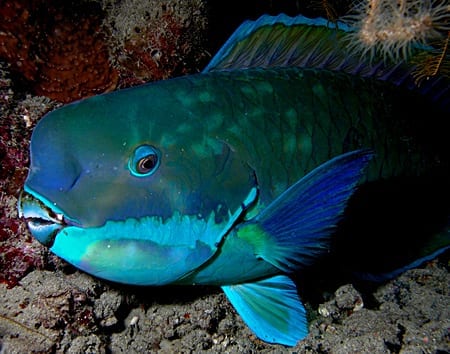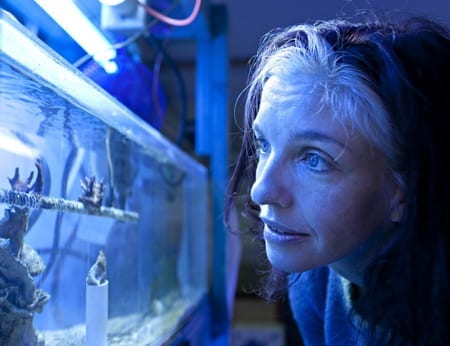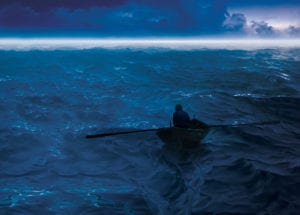By Daniel de la Calle
Here are a few Ocean and Ocean Acidification news bits found while surfing the web over the past week. I hope some are news to you:
•How long has man been catching fish from the open ocean? 42,000 years at the very least. Archeologists from the Australian National University in Canberra have found two broken fish hooks made from shells amongst 38,000 fish bones in a cave in East Timor. It is not known how the fish were caught, but researchers speculate that it was done from boats or rafts using either nets or fiber lines with hooks. Published three days ago in the journal SCIENCE. READ IT HERE.

The fishing hooks. Scale is in millimeters.
•According a study in the current issue of Proceedings of the Royal Society B: Biological Sciences by researchers led by David Bellwood from James Cook University in Queensland, the depletion of large fish due to overfishing can lead to a reef containing only small fish that cannot perform crucial cleaning tasks for the development and sprouting of new colonies. Research focused on parrotfish across 18 locations from the western Indian and Central Pacific Oceans and concluded that large parrotfish are the real efficient pruners and cleaners of vast reef systems thanks to their jaw size.

Chlorunus Microrhinos parrotfish from the North coast of East Timor. Photo by Nick Hobgood, Wikipedia.
In their absence, small fish can only do their light grazing activities that are known as “dusting”. An increase in the number of small fish means the dusting is overdone while the mowing and weeding is being neglected. Once again, a lesson on moderation and the fragility of ecological balance. Read more HERE or HERE.
•Colleen Flanigan, an environmental artist and metallurgist from the US is going to use Biorock (a trademark technology developed in the 1970s that runs a low-voltage electric current through metal in saltwater, causing the accumulation of limestone) to grow a coral colony on a metal sculpture. The sculpture was built in Cancún last June; it has a 15 by 6 feet sinuous design inspired by the DNA double helix and is planned to be lowered via crane into the shallow waters of MUSA, the underwater museum off Cancún I wrote about last year, the one with the 400 life-size submerged sculptures by Jason deCaires Taylor. The electrolysis taking place with Biorock lowers the acidity of water and could one day make possible small “artificial” niches of corals in a marine environment that might otherwise be hostile to polyps. READ MORE HERE.
 Artist Colleen Flanigan. Photo by Ray Whitehouse/The Oregonian
Artist Colleen Flanigan. Photo by Ray Whitehouse/The Oregonian
•Going much farther back than the aforementioned 42,000 years, to some 250 million ago, about 95% of our planet’s marine life and some 70% of all terrestrial species vanished forever as wildfires covered the planet, oceans acidified and temperatures soared. A research team led by Shu-Zhong Shen, member of China’s Nanjing Institute of Geology and Paleontology believes evidence points to a “runaway greenhouse event”. A study published last week on Science gives the most detailed picture yet on how the Permian mass extinction unfolded. Our current problem comes from fossil fuel burnings, while during the Permian period the culprits were volcanoes releasing massive amounts of CO2 and methane. Geological and also fossil records point to several “kill mechanisms”, such as fires, acidification, loss of oxygen in the oceans and even hypercapnia (too much CO2 build up in organisms, causing death). The world’s climate at the end of the Permian changed “from basically like today, where you had hot tropics and cooler polar regions, to a world in which everything was a tropics”, says Charles Henderson, of the University of Calgary. This catastrophe did not happen overnight, though. It took thousands of years to die out and the bulk of the extinctions most probably occurred over a 20,000 year period. Link to an article on the VANCOUVER SUN covering this information.
•PDF on the Impact of Ocean Acidification on Reproduction, Early Development and Settlement of Marine Organisms HERE.
•The Carnegie Institution for Science series of videos about Ocean Acidification research done in Australia continues. This is the one from November 12th:
•Interested in the Effects of Ocean Acidification on Sexual Reproduction and Early Life History Stages of Reef-Building Corals? HERE you can quench that thirst.
•An 8 minute podcast on Ocean Acidification with Joan Kleypas, 2011 Heinz Award winner. From EarthSky.org
•Mark Hays , biology professor at Georgia Tech, writes from Fiji about his research and corals at the New York Times Scientists At Work blog.
http://scientistatwork.blogs.nytimes.com/2011/10/12/a-disappearing-underwater-world/
•Ph.D. graduate research assistant position in zooplankton ecology and biological oceanography at the School of Oceanography of the University of Washington. INFO HERE.
•In need of some beautiful time lapse views of our planet from Space to be reminded of its magnificence and our technical achievements?:
Earth | Time Lapse View from Space, Fly Over | NASA, ISS from Michael König on Vimeo.


